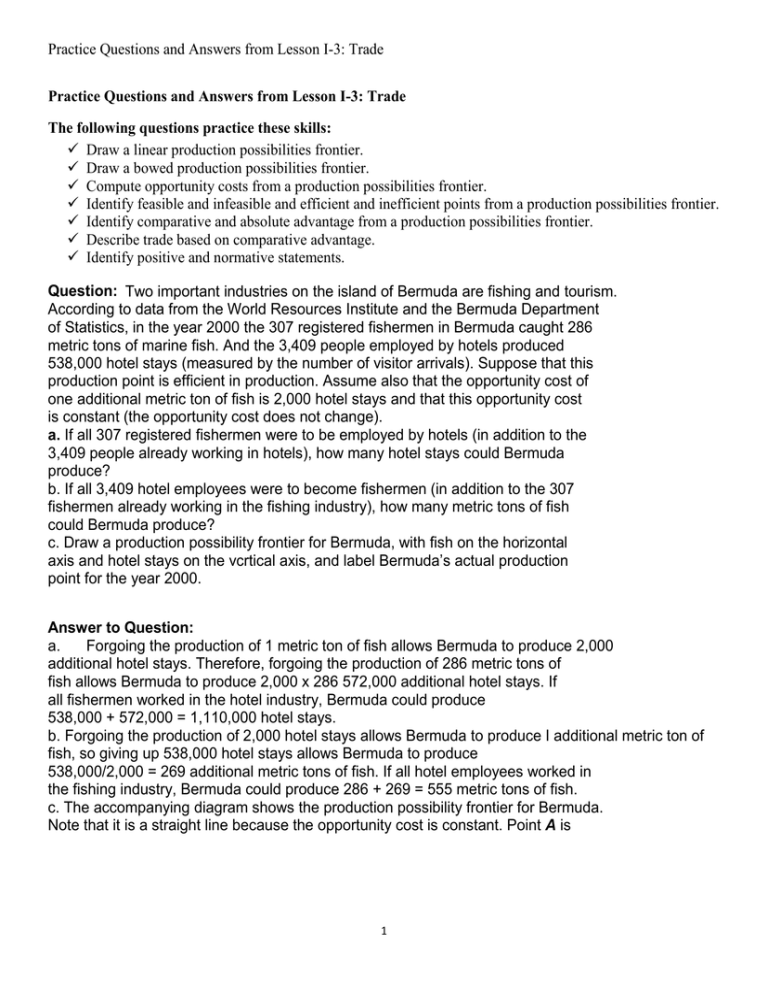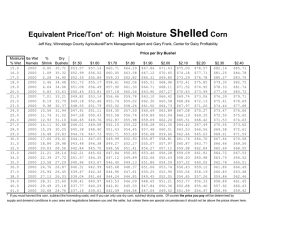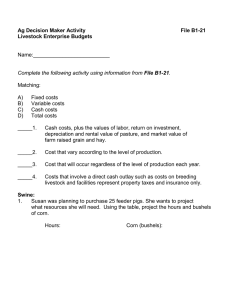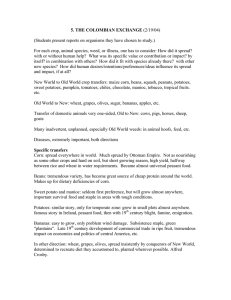Practice Questions and Answers from Lesson I
advertisement

Practice Questions and Answers from Lesson I-3: Trade Practice Questions and Answers from Lesson I-3: Trade The following questions practice these skills: Draw a linear production possibilities frontier. Draw a bowed production possibilities frontier. Compute opportunity costs from a production possibilities frontier. Identify feasible and infeasible and efficient and inefficient points from a production possibilities frontier. Identify comparative and absolute advantage from a production possibilities frontier. Describe trade based on comparative advantage. Identify positive and normative statements. Question: Two important industries on the island of Bermuda are fishing and tourism. According to data from the World Resources Institute and the Bermuda Department of Statistics, in the year 2000 the 307 registered fishermen in Bermuda caught 286 metric tons of marine fish. And the 3,409 people employed by hotels produced 538,000 hotel stays (measured by the number of visitor arrivals). Suppose that this production point is efficient in production. Assume also that the opportunity cost of one additional metric ton of fish is 2,000 hotel stays and that this opportunity cost is constant (the opportunity cost does not change). a. If all 307 registered fishermen were to be employed by hotels (in addition to the 3,409 people already working in hotels), how many hotel stays could Bermuda produce? b. If all 3,409 hotel employees were to become fishermen (in addition to the 307 fishermen already working in the fishing industry), how many metric tons of fish could Bermuda produce? c. Draw a production possibility frontier for Bermuda, with fish on the horizontal axis and hotel stays on the vcrtical axis, and label Bermuda’s actual production point for the year 2000. Answer to Question: a. Forgoing the production of 1 metric ton of fish allows Bermuda to produce 2,000 additional hotel stays. Therefore, forgoing the production of 286 metric tons of fish allows Bermuda to produce 2,000 x 286 572,000 additional hotel stays. If all fishermen worked in the hotel industry, Bermuda could produce 538,000 + 572,000 = 1,110,000 hotel stays. b. Forgoing the production of 2,000 hotel stays allows Bermuda to produce I additional metric ton of fish, so giving up 538,000 hotel stays allows Bermuda to produce 538,000/2,000 = 269 additional metric tons of fish. If all hotel employees worked in the fishing industry, Bermuda could produce 286 + 269 = 555 metric tons of fish. c. The accompanying diagram shows the production possibility frontier for Bermuda. Note that it is a straight line because the opportunity cost is constant. Point A is 1 Practice Questions and Answers from Lesson I-3: Trade Bermuda’s actual production point. Question: Atlantis is a small, isolated island in the South Atlantic. The inhabitants grow potatoes and catch fish. The accompanying table shows the maximum annual output combinations of potatoes and fish that can be produced. Obviously, given their limited resources and available technology, as they use more of their resources for potato production, there are fewer resources available for catching fish. Maximum annual output options Quantity of potatoes (pounds) Quantity of fish (pounds) A B C D E F 1,000 800 600 400 200 0 0 300 500 600 650 675 a. Draw a production possibility frontier with potatoes on the horizontal axis and fish on the vertical axis illustrating these options, showing points A–F. b. Can Atlantis produce 500 pounds of fish and 800 pounds of potatoes? Explain. Where would this point lie relative to the production possibility frontier? c. What is the opportunity cost of increasing the annual output of potatoes from 600 to 800 pounds? d. What is the opportunity cost of increasing the annual output of potatoes from 200 to 400 pounds? e. Can you explain why the answers to parts c and d are not the same? What does this imply about the slope of the production possibility frontier? Answer to Question: 2 Practice Questions and Answers from Lesson I-3: Trade a. The accompanying diagram shows the production possibility frontier for Atlantis. b. No, Atlantis cannot produce 500 pounds of fish and 800 pounds of potatoes. If it produces 500 pounds of fish, the most potatoes it can produce is 600 pounds. This point would lie outside the production possibility frontier, at point G on the diagram. c. The opportunity cost of increasing output from 600 to 800 pounds of potatoes is 200 pounds of fish. If Atlantis increases output from 600 to 800 pounds of potatoes, it has to cut fish production from 500 pounds to 300 pounds, that is, by 200 pounds. d. The opportunity cost of increasing output from 200 to 400 pounds of potatoes is 50 pounds of fish. If Atlantis increases output from 200 to 400 pounds of potatoes, it has to cut fish production from 650 pounds to 600 pounds, that is, by 50 pounds. e. The answers to parts c and d imply that the more potatoes Atlantis produces, the higher the opportunity cost becomes. For instance, as you grow more and more potatoes, you have to use less and less suitable land to do so. As a result, you have to divert increasingly more resources away from fishing as you grow more potatoes, meaning that you can produce increasingly less fish. This implies, of course, that the production possibility frontier becomes steeper the farther you move along it to the right; that is, the production possibility frontier is bowed out. (Mathematicians call this shape concave.) Question: According to data from the U.S. Department of Agriculture’s National Agricultural Statistics Service, 124 million acres of land in the United States were used for wheat or corn farming in 2004. Of those 124 million acres, farmers used 50 million acres to grow 2.158 billion bushels of wheat and 74 million acres of land to grow 11.807 billion bushels of corn. Suppose that U.S. wheat and corn farming is efficient in production. At that production point, the opportunity cost of producing one additional bushel of wheat is 1.7 fewer bushels of corn. However, farmers have increasing opportunity costs, so that additional bushels of wheat have an opportunity cost greater than 1.7 bushels of corn. For each of the following production points, decide whether that production point is (i) feasible and efficient in production, (ii) feasible but not efficient in production, (iii) not feasible, or (iv) unclear as to whether or not it is feasible. a. Farmers use 40 million acres of land to produce 1.8 billion bushels of wheat, and they use 60 million acres of land to produce 9 billion bushels of corn. The remaining 24 million acres are left unused. b. From their original production point, farmers transfer 40 million acres of land from corn to wheat production. They now produce 3.158 billion bushels of wheat and 10.107 bushels of corn. c. Farmers reduce their production of wheat to 2 billion bushels and increase their production of corn to 12.044 billion bushels. Along the production possibility frontier, the opportunity cost of going from 11.807 billion bushels of corn to 12.044 billion bushels of corn is 0.666 bushel of wheat per bushel of corn. Answer to Question: a. This point is feasible but not efficient in production. Producing 1.8 billion bushels of wheat and 9 billion bushels of corn is less of both wheat and corn than is possible. They could produce more if all the available farmland were cultivated. b. At this new production point, farmers would now produce 1 billion more bushels of wheat and 1.7 billion fewer bushels of corn than at their original production point. This reflects an opportunity cost of 1.7 bushels of corn per additional bushel of wheat. But, in fact, this new production point is not feasible 3 Practice Questions and Answers from Lesson I-3: Trade because we know that opportunity costs are increasing. Starting from the original production point, the opportunity cost of producing one more bushel of wheat must be higher than 1.7 bushels of corn. c. This new production point is feasible and efficient in production. Along the production possibility frontier, the economy must forgo 0.666 bushels of wheat per additional bushel of corn. So the increase in corn production from 11.807 billion bushels to 12.044 billion bushels costs the economy (12.044 − 11.807) billion bushels of corn × 0.666 bushel of wheat per bushel of corn = 0.158 bushel of wheat. This is exactly equal to the actual loss in wheat output: the fall from 2.158 billion to 2 billion bushels of wheat. Question: According to the U.S. Census Bureau, in July 2006 the United States exported aircraft worth $1 billion to China and imported aircraft worth only $19,000 from China. During the same month, however, the United States imported $83 million worth of men’s trousers, slacks, and jeans from China but exported only $8,000 worth of trousers, slacks, and jeans to China. Using what you have learned about how trade is determined by comparative advantage, answer the following questions. a. Which country has the comparative advantage in aircraft production? In production of trousers, slacks, and jeans? b. Can you determine which country has the absolute advantage in aircraft production? In production of trousers, slacks, and jeans? Answer to Question: a. Since countries gain from specializing in production of the goods and services in which they have a comparative advantage, the United States must have the comparative advantage in aircraft production, and China must have the comparative advantage in production of trousers, slacks, and jeans. b. Since trade has nothing to do with absolute advantage, we cannot determine from this data which country has an absolute advantage in either of these goods. Question: Peter Pundit, an economics reporter, states that the European Union (EU) is increasing its productivity very rapidly in all industries. He claims that this productivity advance is so rapid that output from the EU in these industries will soon exceed that of the United States and, as a result, the United States will no longer benefit from trade with the EU. a. Do you think Peter Pundit is correct or not? If not, what do you think is the source of his mistake? b. If the EU and the United States continue to trade, what do you think will characterize the goods that the EU exports to the United States and the goods that the United States exports to the EU? Answer to Question: a. Peter Pundit is not correct. He confuses absolute and comparative advantage. Even if the EU had an absolute advantage over the United States in every product it produced, the United States would still have a comparative advantage in some products. And the United States should continue to produce those products: trade will make both the EU and the United States better off. b. You should expect to see the EU export those goods in which it has the comparative advantage and the United States export those goods in which it has the comparative advantage. Question: A representative of the American clothing industry recently made the following statement: “Workers in Asia often work in sweatshop conditions earning only pennies an hour. American workers are more productive and as a result earn higher wages. In order to preserve the dignity of the American 4 Practice Questions and Answers from Lesson I-3: Trade workplace, the government should enact legislation banning imports of low-wage Asian clothing.” a. Which parts of this quote are positive statements? Which parts are normative statements? b. Is the policy that is being advocated consistent with the preceding statements about the wages and productivities of American and Asian workers? c. Would such a policy make some Americans better off without making any other Americans worse off? That is, would this policy be efficient from the viewpoint of all Americans? d. Would low-wage Asian workers benefit from or be hurt by such a policy? Solution Answer to Question: a. The positive statements are: ■ workers in Asia . . . [are] earning only pennies an hour ■ American workers are more productive ■ American workers are more productive and as a result earn higher wages The normative statement is: ■ the government should enact legislation banning imports of low-wage Asian clothing b. It is not. The statement about the productivity of American and Asian workers is about the absolute advantage that American workers have over Asian workers. However, Asian workers may still have a comparative advantage. And if that is the case, then banning imports would result in inefficiency. c. If America channeled more of its productive resources into producing clothing, it would have to give up producing other goods. As a result, America would be able to consume less of all goods. And this would make some Americans clearly worse off. Therefore, this policy would not be efficient. d. Low-wage Asian workers would also be hurt by this policy. The Asian country would channel its resources away from producing clothing toward producing other goods that it previously imported from America. But since it does not have the comparative advantage in those other goods, the Asian country would be able to consume less of all goods. Question: The mayor of Gotham City, worried about a potential epidemic of deadly influenza this winter, asks an economic adviser the following series of questions. Determine whether a question requires the economic adviser to make a positive assessment or a normative assessment. a. How much vaccine will be in stock in the city by the end of November? b. If we offer to pay 10% more per dose to the pharmaceutical companies providing the vaccines, will they provide additional doses? c. If there is a shortage of vaccine in the city, whom should we vaccinate first—the elderly or the very young? (Assume that a person from one group has an equal likelihood of dying from influenza as a person from the other group.) d. If the city charges $25 per shot, how many people will pay? e. If the city charges $25 per shot, it will make a profit of $10 per shot, money that can go to pay for inoculating poor people. Should the city engage in such a scheme? Answer to Question: a. Positive b. Positive 5 Practice Questions and Answers from Lesson I-3: Trade c. Normative d. Positive e. Normative 6






